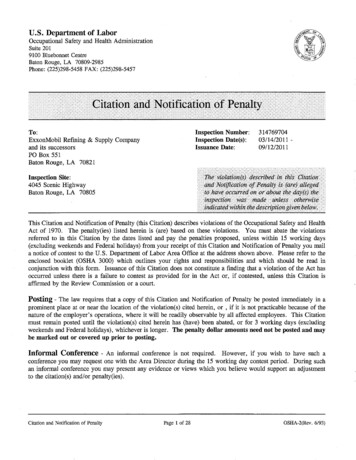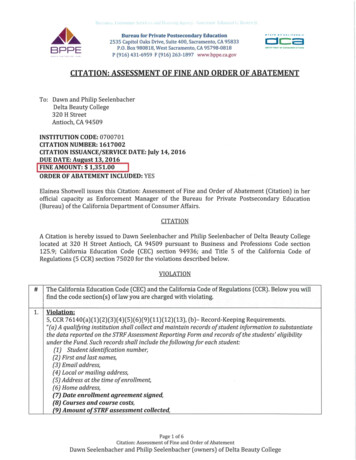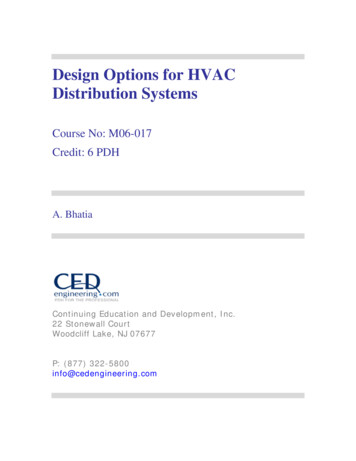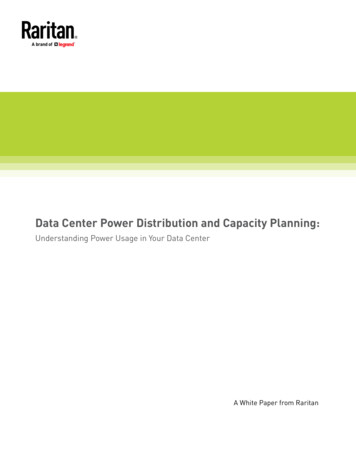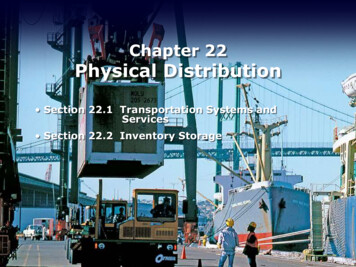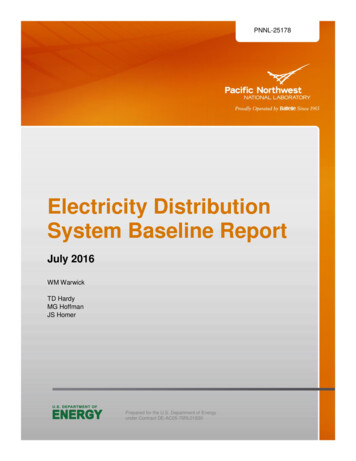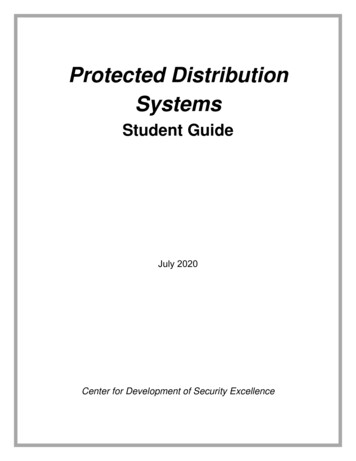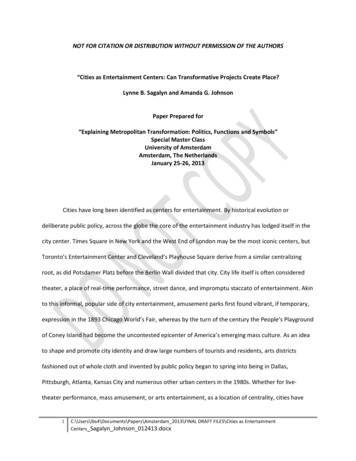
Transcription
NOT FOR CITATION OR DISTRIBUTION WITHOUT PERMISSION OF THE AUTHORS“Cities as Entertainment Centers: Can Transformative Projects Create Place?Lynne B. Sagalyn and Amanda G. JohnsonPaper Prepared for“Explaining Metropolitan Transformation: Politics, Functions and Symbols”Special Master ClassUniversity of AmsterdamAmsterdam, The NetherlandsJanuary 25-26, 2013Cities have long been identified as centers for entertainment. By historical evolution ordeliberate public policy, across the globe the core of the entertainment industry has lodged itself in thecity center. Times Square in New York and the West End of London may be the most iconic centers, butToronto’s Entertainment Center and Cleveland’s Playhouse Square derive from a similar centralizingroot, as did Potsdamer Platz before the Berlin Wall divided that city. City life itself is often consideredtheater, a place of real-time performance, street dance, and impromptu staccato of entertainment. Akinto this informal, popular side of city entertainment, amusement parks first found vibrant, if temporary,expression in the 1893 Chicago World’s Fair, whereas by the turn of the century the People’s Playgroundof Coney Island had become the uncontested epicenter of America’s emerging mass culture. As an ideato shape and promote city identity and draw large numbers of tourists and residents, arts districtsfashioned out of whole cloth and invented by public policy began to spring into being in Dallas,Pittsburgh, Atlanta, Kansas City and numerous other urban centers in the 1980s. Whether for livetheater performance, mass amusement, or arts entertainment, as a location of centrality, cities have1C:\Users\lbs4\Documents\Papers\Amsterdam 2013\FINAL DRAFT FILES\Cities as EntertainmentCenters Sagalyn Johnson 012413.docx
long had a competitive advantage, and this has been no less the case as evolving cultural notions ofentertainment increasingly have shifted to sports events and produced new large-format entertainmentcenters such as London’s O2, L.A. Live!, and Amsterdam ArenA.Some of these new-generation entertainment centers have been developed in the core of cities,yet others on the periphery of a center city. In either urban location, the overriding function of theinitiative, typically a public-private venture brought about through public intervention and helped alongwith public financial assistance, is a sought-after transformation of place. Not infrequently,entertainment projects, particularly sports centers, have evoked high-profile controversy and conflict,and questions of public purpose and public benefit (Fulton 1997, Noll and Zimbalist 1997, Gruen 1998,Goss 1999, Chapin 2004). 1 In this paper, the authors explain how concentrated entertainment centersevolve in the United States, and how the interplay of public policy and market economics shapesdevelopment and catalyzes new identities. We are most interested in understanding what kinds ofentertainment projects have been successful in effectuating urban transformation, and seek exploratoryanswers to a number of questions: Why is it that entertainment projects more often than not are sitedin dense urban areas, though not necessarily in the core? Is a central location necessary for success?How does the accumulated social capital of a city predispose or predetermine the site of entertainmentactivity? In areas of the city where such accumulated social capital may not exist, areas where a “place”would have to be created by an invented destination activity, what kind of critical mass is necessary to1Sports stadia have been the focus of numerous studies seeking to evaluate the economic return involved for theowners and cities providing financial support. The results have been consistently negative: baseball parks seldom,if ever pay their own way or create real economic development (Baim 1994, Noll and Zimbalist 1997, Rosentraub1997), though downtown locations may create more position impacts that other locations (Melaniphy 1996), allcited in Newsome and Comer 2000. In fact, empirical analysis by Newsome and Comer show that thesuburbanization trend long associated with the location of U.S. major sporting venue construction is reversingitself, with resurgence in downtown venues. They attribute this to a concomitant trend toward smaller marketfranchises, increasing corporate sponsorship, deliberate downtown revitalization strategies, and the advantagesaccruing to owners when different parts of an urban area compete for franchises. Nelson’s analysis of the locationof major league stadiums in twenty-five U.S. metropolitan areas (2002) showed that in terms of capturing share ofeconomic activity, the best location for professional sports stadiums appears to be downtown (including thecentral business district and nearby “edge” areas), followed by other locations in the central city, while suburbanlocations appeared to be associated with the least amount of economic activity.2C:\Users\lbs4\Documents\Papers\Amsterdam 2013\FINAL DRAFT FILES\Cities as EntertainmentCenters Sagalyn Johnson 012413.docx
support the transformative project? In other words, to what extent can a catalytic transformationproject create the basis for a future accumulation of social capital? And what types of public policies andincentives are employed—and to what effect—to create the necessary market context for arts andentertainment-based transformative projects? All of which reduces to the question, can today’sentertainment-oriented transformative projects create “place”?In the first section of the paper we discuss the idea of transformation as a planning goal tocreate place and make the argument that city locations, whether in the center or on the periphery, holdcompetitive advantages over suburbs when it comes to creating place, especially in the instance ofentertainment. We think of place creation as an ambitious mandate beyond the conventional tool kit ofplanning professionals; consequently, in most cases, embarking on a quest to invent place throughlarge-scale policy intervention typically involves a specialized set of professional skills that have to betapped through the use of specialized consultants and public-private partnerships. Place can be createdthrough a number of different approaches, which we briefly discuss in this first section. Urbanentertainment concentrations have exhibited many different formats over the past several decades ofexperimentation. In the second section of the paper we present a typology for organizing these manyformats and compare across nine identifying attributes, emphasizing for the focus of this volume,primary location in the core of periphery. In the third and fourth sections, we explain thetransformation process of two multi-purpose entertainment complexes: one in the core (42nd Street atTimes Square), the other in the periphery of the core (L.A. Live!). There two very distinct and differententertainment places are considered by many to be models for adaptation by other cities. On the basisof these cases and our general ideas on the question, we conclude with observations on transformationprojects as a way to create place.3C:\Users\lbs4\Documents\Papers\Amsterdam 2013\FINAL DRAFT FILES\Cities as EntertainmentCenters Sagalyn Johnson 012413.docx
Transformation and the Place MandateWhat do we mean by “place?” What motivates cities to want “places?” Today’s city planners in theUnited States grapple with these questions as they are charged with a mandate that goes beyond thetraditional goal of providing a rational context for orderly and stable growth of developing urban areas.Whereas traditional planning practice focused on promoting quality-of-life attributes which have cometo define the most admired urban neighborhoods and suburban communities (generous open space,park-like amenities, pedestrian-oriented retail activity, street patterns that facilitate neighborlycommunication), the “place” mandate calls upon city planners to go beyond the design template forgood domestic living and develop plans for interactive socially-oriented entertainment and leisureactivity. To meet the ambitions of municipal governments they are being asked to develop plans andshape commercial real estate projects in ways that promote economic development, supportsustainable development, create the excitement of distinctive venues, and impart prestige and the auraof success to large-scale multi-functional public interventions that aim to become “places.” In urbancenters, the goal of creating “place” has come to mean long-term sustainable effect: diverse anddistinctive mixed-use commercial activity characterized by 24/7 vibrancy and dynamic quality night life,one measure of a city’s sophistication. This, of course, represents the antithesis of the suburbanplanning ideal, which in physical form and normative design was meant to be a retreat from theintensity of city life realized through a primarily residential community that embodied the ideal of a safe,secure domestic life. What then does the literature suggest as necessary and essential for making realthe new place-making mandate?We know “place” when we encounter it, through personal experience. Sometimes, theexperience of place comes from feeling history through a landmark of transcendent national memorysuch as the Gettysburg Battlefield or experiencing civic passion through a local baseball team; Brooklyn4C:\Users\lbs4\Documents\Papers\Amsterdam 2013\FINAL DRAFT FILES\Cities as EntertainmentCenters Sagalyn Johnson 012413.docx
fans, for example, still bemoan the loss of the Dodgers, some fifty-four years after the team decampedto Los Angeles. Other times, the experience originates with a local political, cultural, or social event ofmeaning and fixes in memory on an urban place where people naturally congregate to share events orhear announcements of something important, New Year’s Eve in New York’s Times Square, for example.Still other times, the experience of place comes from the personal meaning of encounter, whereindividual social interactions occur on a daily basis, at the local post office, public park, shopping district,or central transportation node such as the main concourse at Grand Central Terminal in New York,where, in words Tony Hiss wrote in The Experience of Place, the “experience is one of the unplannedtreasures of New York” (1990, 4). In each of these instances, the meaning of place arises out of socialinteractions—a connectedness—and in that sense, place can be said to be socially constructed (Adamsand Tiesdell 2013, 11).Whether fashioned somewhat spontaneously by unconnected private-market decisions by realestate developers and individuals or intentionally crafted by public interventions, the physicaldevelopment of place is distinct from a singular building or development project. It is not a function ofspecific architecture, rather, from the perspective of urban design, a conceptual approach and explicitplan for creating a total experience. Toward that end, Adams and Tiesdall (2013) have defined thecharacteristics of successful places by the five following attributes: places meant for people, whereactivity draws people; places that are well-connected and permeable by easy physical access, easywalkability, and easy connectivity; places of mixed uses and varied density which shape its vitality andhow well it is used; places of distinction that counter the standardization of place that has become alltoo familiar as local processes of development have been overtaken by national and corporatedevelopment enterprises, especially in retailing, and offer authenticity of location; and sustainable,resilient, and robust places that can be successful over time.5C:\Users\lbs4\Documents\Papers\Amsterdam 2013\FINAL DRAFT FILES\Cities as EntertainmentCenters Sagalyn Johnson 012413.docx
Places of distinction in the field of urban entertainment, however, are becoming more andmore difficult given the rise of branded corporate entertainment (David 1999, Hollands and Chatterton2003, Bruck 2012), and the tensions raised to when access to that entertainment only comes withpayment, even though public financial assistance may have been an essential element of a project’sfeasibility. Beyond the issue of who is doing the actual production, successful urban places engagepeople in active involvement of experience beyond the experience of being a spectator (15-30). Placemaking is about creating urban experiences that will be remembered and repeated, experiences thatoften cannot be created all at once out of whole cloth or that rely on historical legacy or other factorsthat have little to do with the physical development itself. As such, the urban fabric of a city, with itssocial capital built up over decades and decades of public and private investment, tends to lend itselfmore readily to the creation of place than do suburban greenfields.Urban economic theory also strongly suggests that cities hold a natural competitive advantageover suburban locations when it comes to developing place-defining entertainment venues. Thepopulation density of cities confers the potential of critical mass, scale being an especially importantconsideration for the production of entertainment (Florida et al 2012). Transportation systems,especially mass transit, make possible efficient travel of thousands, even hundreds of thousands ofentertainment seekers, delivering them to the doors of these venues without dedicating acres of land tohumongous, contiguous areas of parking-lot isolation. Historic associations of place, whether a muchloved iconic baseball stadium or much-remembered World’s Fairground or Olympics Park, also factorinto the equation of competitive advantage. The agglomeration of economies that define cities providesa diverse mix of commercial activities drawing a broad range of consumers beyond what might benecessary to support the level of consumer activity of any one entertainment activity.6C:\Users\lbs4\Documents\Pap
yet others on the periphery of a center city. In either urban location, the overriding function of the initiative, typically a public-private venture brought about through public intervention and helped along with public financial assistance, is a sought-after transformation of place. Not infrequently, entertainment projects, particularly sports centers, have evoked high-profile controversy .

